Belarus

Belarus

| Capital | Minsk |
|---|---|
| Official languages | |
| Recognized minority language | |
| Ethnic groups | |
| Demonym(s) | Belarusian |
| Government | Unitarypresidential republic |
| Alexander Lukashenko | |
| Sergey Rumas | |
| Legislature | National Assembly |
| Council of the Republic | |
| Establishment history | |
| 987 | |
| c. 1236 | |
| 1 July 1569 | |
| 1795 | |
| 25 March 1918 | |
| 17 February 1919 | |
| 31 July 1920 | |
| 15 November 1939 | |
| 27 July 1990 | |
| 25 August 1991 | |
| 8 December 1991 | |
| 26 December 1991 | |
| 15 March 1994 | |
| 2 April 1996 | |
| Area | |
| 207,595 km (80,153 sq mi) (84th) | |
| 1.4% (2.830 km or 1.093 sq mi) | |
| Population | |
| 9,491,800[2](93rd) | |
| 45.8/km (118.6/sq mi) (142nd) | |
| GDP | 2019 estimate |
| $195 billion[3] | |
| $20,820[3] | |
| GDP | 2019 estimate |
| $60 billion[3] | |
| $6,477[3] | |
| Gini | |
| HDI | |
| Currency | Belarusian ruble(BYN) |
| Time zone | (FET) |
| Date format | dd.mm.yyyy |
| Driving side | right |
| Calling code | +375 |
| ISO 3166 code | BY |
| Internet TLD | |
Belarus (/bɛləˈruːs/; Belarusian: Беларусь, IPA: [bʲɛlaˈrusʲ]), officially the Republic of Belarus (Belarusian: Рэспубліка Беларусь, Russian: Республика Беларусь), formerly known by its Russian name Byelorussia or Belorussia (Russian: Белоруссия), is a landlocked country in Eastern Europe[7] bordered by Russia to the northeast, Ukraine to the south, Poland to the west, and Lithuania and Latvia to the northwest. Its capital and most populous city is Minsk. Over 40% of its 207,600 square kilometres (80,200 sq mi) is forested. Its major economic sectors are service industries and manufacturing.[8] Until the 20th century, different states at various times controlled the lands of modern-day Belarus, including the Principality of Polotsk (11th to 14th centuries), the Grand Duchy of Lithuania, the Polish–Lithuanian Commonwealth, and the Russian Empire.
In the aftermath of the 1917 Russian Revolution, Belarus declared independence as the Belarusian People's Republic, which was conquered by Soviet Russia. The Socialist Soviet Republic of Byelorussia became a founding constituent republic of the Soviet Union in 1922 and was renamed as the Byelorussian Soviet Socialist Republic (Byelorussian SSR). Belarus lost almost half of its territory to Poland after the Polish–Soviet War of 1919–1921. Much of the borders of Belarus took their modern shape in 1939, when some lands of the Second Polish Republic were reintegrated into it after the Soviet invasion of Poland, and were finalized after World War II.[9][10][11] During WWII, military operations devastated Belarus, which lost about a third of its population and more than half of its economic resources.[12] The republic was redeveloped in the post-war years. In 1945 the Byelorussian SSR became a founding member of the United Nations, along with the Soviet Union and the Ukrainian SSR.[13]
The parliament of the republic proclaimed the sovereignty of Belarus on 27 July 1990, and during the dissolution of the Soviet Union, Belarus declared independence on 25 August 1991.[14] Alexander Lukashenko has served as the country's first president since 1994. Belarus has been labeled "Europe's last dictatorship" by some Western journalists,[15][16] on account of Lukashenko's self-described authoritarian style of government.[17][18][19] Lukashenko continued a number of Soviet-era policies, such as state ownership of large sections of the economy. Elections under Lukashenko's rule have been widely criticized as unfair; and according to many countries and organizations, political opposition has been violently suppressed. Belarus is also the last country in Europe using the death penalty.[20][21][22] Belarus's Democracy Index rating is the lowest in Europe, the country is labelled as "not free" by Freedom House, as "repressed" in the Index of Economic Freedom, and is rated as by far the worst country for press freedom in Europe in the 2013–14 Press Freedom Index published by Reporters Without Borders, which ranks Belarus 157th out of 180 nations.[23]
In 2000, Belarus and Russia signed a treaty for greater cooperation, forming the Union State. Over 70% of Belarus's population of 9.49 million resides in urban areas. More than 80% of the population is ethnic Belarusian, with sizable minorities of Russians, Poles and Ukrainians. Since a referendum in 1995, the country has had two official languages: Belarusian and Russian. The Constitution of Belarus does not declare any official religion, although the primary religion in the country is Eastern Orthodox Christianity. The second-most widespread religion, Roman Catholicism, has a much smaller following; nevertheless, Belarus celebrates both Orthodox and Catholic versions of Christmas and Easter as national holidays.[24] Belarus is a member of the United Nations since its founding, the Commonwealth of Independent States, CSTO, EEU, and the Non-Aligned Movement. Belarus has shown no aspirations for joining the European Union but nevertheless maintains a bilateral relationship with the organisation, and likewise participates in two EU projects: the Eastern Partnership and the Baku Initiative.
| Capital | Minsk |
|---|---|
| Official languages | |
| Recognized minority language | |
| Ethnic groups | |
| Demonym(s) | Belarusian |
| Government | Unitarypresidential republic |
| Alexander Lukashenko | |
| Sergey Rumas | |
| Legislature | National Assembly |
| Council of the Republic | |
| Establishment history | |
| 987 | |
| c. 1236 | |
| 1 July 1569 | |
| 1795 | |
| 25 March 1918 | |
| 17 February 1919 | |
| 31 July 1920 | |
| 15 November 1939 | |
| 27 July 1990 | |
| 25 August 1991 | |
| 8 December 1991 | |
| 26 December 1991 | |
| 15 March 1994 | |
| 2 April 1996 | |
| Area | |
| 207,595 km (80,153 sq mi) (84th) | |
| 1.4% (2.830 km or 1.093 sq mi) | |
| Population | |
| 9,491,800[2](93rd) | |
| 45.8/km (118.6/sq mi) (142nd) | |
| GDP | 2019 estimate |
| $195 billion[3] | |
| $20,820[3] | |
| GDP | 2019 estimate |
| $60 billion[3] | |
| $6,477[3] | |
| Gini | |
| HDI | |
| Currency | Belarusian ruble(BYN) |
| Time zone | (FET) |
| Date format | dd.mm.yyyy |
| Driving side | right |
| Calling code | +375 |
| ISO 3166 code | BY |
| Internet TLD | |
Etymology

Stamp with the Cross of St. Euphrosyne from 1992
The name Belarus is closely related with the term Belaya Rus', i.e., White Rus'. There are several claims to the origin of the name White Rus'. [25] An ethno-religious theory suggests that the name used to describe the part of old Ruthenian lands within the Grand Duchy of Lithuania that had been populated mostly by Slavs who had been Christianized early, as opposed to Black Ruthenia, which was predominantly inhabited by pagan Balts.[26]
The name Rus is often conflated with its Latin forms Russia and Ruthenia, thus Belarus is often referred to as White Russia or White Ruthenia. The name first appeared in German and Latin medieval literature; the chronicles of Jan of Czarnków mention the imprisonment of Lithuanian grand duke Jogaila and his mother at "Albae Russiae, Poloczk dicto" in 1381.[28] In some languages, including German, Afrikaans and Dutch, the country is generally called "White Russia" to this day (Weißrussland and Wit-Rusland respectively).[29][30]
The Latin term "Alba Russia" was used again by Pope Pius VI in 1783 to recognize the Society of Jesus there, exclaiming "Approbo Societatem Jesu in Alba Russia degentem, approbo, approbo."[31]The%20Jesu]]he first known use of[[32]](https://openlibrary.org/search?q=Bely%2C%20Alies%20%282000%29.%20 [tsars)[33(https://openlibrary.org/books/OL7403676M/The_Cossacks_and_Religion_in_Early_Modern_Ukraine)
The term Belorussia (Russian: Белору́ссия, the latter part similar but spelled and stressed differently from Росси́я, Russia) first rose in the days of the Russian Empire, and the Russian Tsar was usually styled "the Tsar of All the Russias", as Russia or the Russian Empire was formed by three parts of Russia—the Great, Little, and White.[34] This asserted that the territories are all Russian and all the peoples are also Russian; in the case of the Belarusians, they were variants of the Russian people.[35]
After the Bolshevik Revolution in 1917, the term "White Russia" caused some confusion, as it was also the name of the military force that opposed the red Bolsheviks.[36] During the period of the Byelorussian SSR, the term Byelorussia was embraced as part of a national consciousness. In western Belarus under Polish control, Byelorussia became commonly used in the regions of Białystok and Grodno during the interwar period.[37]
The term Byelorussia (its names in other languages such as English being based on the Russian form) was only used officially until 1991, when the Supreme Soviet of the Byelorussian SSR decreed by law that the new independent republic should be called Republic of Belarus (Республика Беларусь spelled in Russian), and that its abridged form should be "Belarus". The law decreed that all the forms of the new term should be transliterated into other languages from their Belarusian language forms. The use of Byelorussian SSR and any abbreviations thereof were allowed from 1991 to 1993.[38] Conservative forces in the newly independent Belarus did not support the name change and opposed its inclusion in the 1991 draft of the Constitution of Belarus.[[39]](https://openlibrary.org/books/OL8999553M/Eastern_Europe_and_the_Commonwealth_of_Independent_States_1999_(Eastern_Europe_and_the_Commonwealth_)
Accordingly, the name Byelorussia was replaced by Belarus in English.[40] Likewise, the adjective Belorussian or Byelorussian was replaced by Belarusian in English. Belarusian is closer to the original Belarusian term of bielaruski.[40] Belarusian intelligentsia in the Stalin era attempted to change the name from Byelorussia to a form of Krivia because of the supposed connection with Russia.[41] Some nationalists object to the name for the same reason.[42][43] Several local newspapers kept the old name of the country in Russian in their names, for example Komsomolskaya Pravda v Byelorussii, which is the localized publication of a popular Russian newspaper. Also, those who wish for Belarus to be reunited with Russia continue to use Belorussia.[43] Officially, the full name of the country is "Republic of Belarus" (Рэспубліка Беларусь, Республика Беларусь, Respublika Belarus listen ).[38][44]
History
Early history
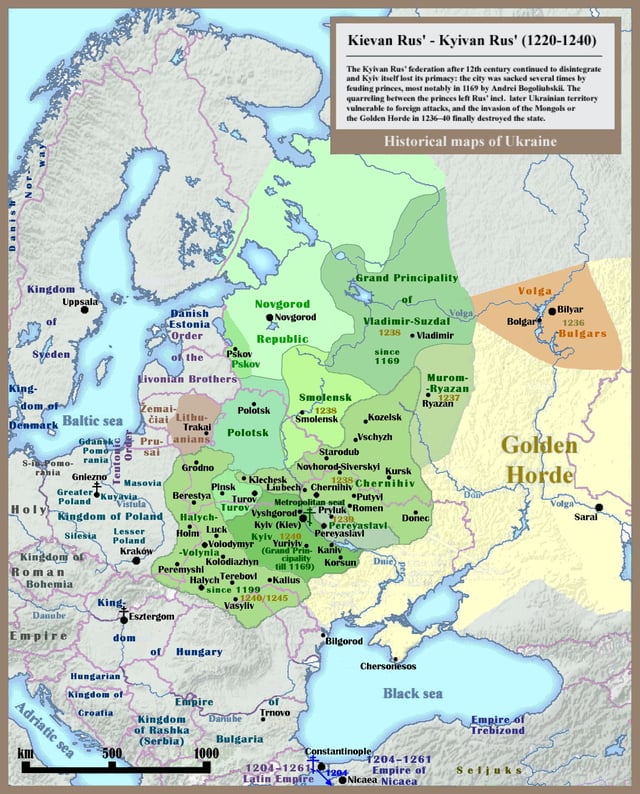
Rus' principalities before the Mongol and Lithuanian invasions
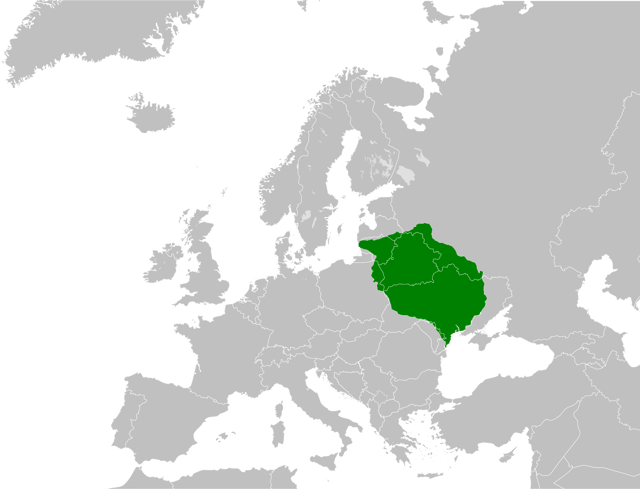
A map of the Grand Duchy of Lithuania in the 15th century. Belarus was fully within its borders.
From 5000 to 2000 BC, Bandkeramik cultures predominated. In addition, remains from the Dnieper-Donets culture were found in Belarus and parts of Ukraine.[45] Cimmerians and other pastoralists roamed through the area by 1,000 BC, and by 500 AD, Slavs had taken up residence, which was circumscribed by the Scythians who roamed its outskirts. Invaders from Asia, among whom were the Huns and Avars, swept through c. 400–600 AD, but were unable to dislodge the Slavic presence.[46]
The region that is now Belarus was first settled by Baltic tribes in the 3rd century. Around the 5th century, the area was taken over by Slavic tribes. The takeover was partially due to the lack of military coordination of the Balts but the gradual assimilation of the Balts into Slavic culture was peaceful in nature.[47]
In the 9th century the territory of modern Belarus became part of Kievan Rus', a vast East Slavic state ruled by the Rurikid dynasty. Upon the death of Kievan Rus' ruler Yaroslav I the Wise, the state split into independent principalities.[48] Many early Rus' principalities were virtually razed or severely affected by a major Mongol invasion in the 13th century, but the lands of modern Belarus avoided the brunt of the invasion and eventually joined the Grand Duchy of Lithuania.[49]
There are no sources of military seizure, but the annals affirm the alliance and united foreign policy of Polotsk and Lithuania for decades.
For example, the Chronicle of Novgorod informs about "Izyaslav had been set to be Knyaz in Luki and covered Novgorod from the Lithuanians" in 1198 when Luki is situated on the east from Polotsk.[50]
Incorporation into the Grand Duchy of Lithuania resulted in an economic, political and ethno-cultural unification of Belarusian lands.[51] Of the principalities held by the Duchy, nine of them were settled by a population that would eventually become Belarusian people.[52] During this time, the Duchy was involved in several military campaigns, including fighting on the side of Poland against the Teutonic Knights at the Battle of Grunwald in 1410; the joint victory allowed the Duchy to control the northwestern borderlands of Eastern Europe.[53]
The Muscovites, led by Ivan III of Moscow, began military campaigns in 1486 in an attempt to incorporate the lands of Kievan Rus', specifically the territories of modern Belarus, Russia and Ukraine.[54]
Polish–Lithuanian Commonwealth
On 2 February 1386, the Grand Duchy of Lithuania and the Kingdom of Poland were joined in a personal union through a marriage of their rulers.[55] This union set in motion the developments that eventually resulted in the formation of the Polish–Lithuanian Commonwealth, created in 1569 by the Union of Lublin.
The Lithuanian nobles were forced to go for rapprochement because of the threat coming from Muscovy. To strengthen the independence in the format of the union, three editions of the Statutes of Lithuania were issued in the 16th century. The third Article of the Statute establishes that all lands of Grand Duchy of Lithuania will be eternally in Grand Duchy of Lithuania and never enter as a part of other states. It allowed to own the land within Grand Duchy of Lithuania only to own families. Anyone from outside Duchy would be honored with property only own it after swearing to Grand Duke of Lithuania. These articles were aimed to defend the rights of the Grand Duchy of Lithuania nobility against Polish, Prussian and other aristocracy of Polish–Lithuanian Commonwealth.
In the years following the union, the process of gradual Polonization of both Lithuanians and Ruthenians gained steady momentum. In culture and social life, both the Polish language and Catholicism became dominant, and in 1696, Polish replaced Ruthenian as the official language—with the Ruthenian language being banned from administrative use.[56] However, the Ruthenian peasants, continued to speak their own language and remained faithful to the Belarusian Greek Catholic Church. Statutes were initially only issued in Ruthenian language and later also in Polish. Around 1840 the Statutes were banned by the Russian tsar following the November Uprising. Modern Ukrainian lands used it until 1860s.
Russian Empire
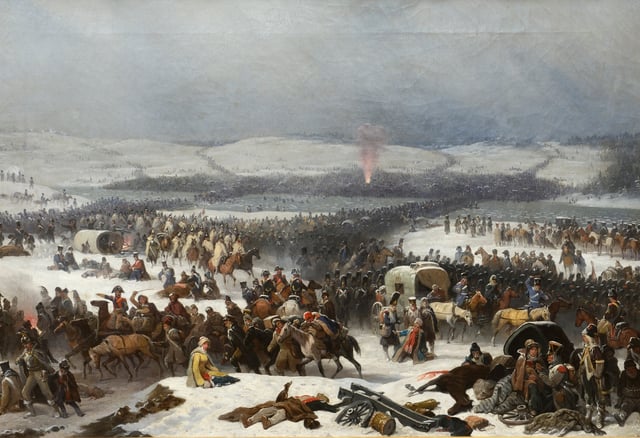
Napoleon's Grande Armée retreating after his invasion of Russia and crossing the Berezina river (near Barysaw, Belarus)
The union between Poland and Lithuania ended in 1795 with the Third Partition of Poland by Imperial Russia, Prussia, and Austria.[57] The Belarusian territories acquired by the Russian Empire under the reign of Catherine II[58] were included into the Belarusian Governorate (Russian: Белорусское генерал-губернаторство) in 1796 and held until their occupation by the German Empire during World War I.[59]
Under Nicholas I and Alexander III the national cultures were repressed. Policies of Polonization[60] changed by Russification,[61] which included the return to Orthodox Christianity of Belorusian Uniates. Belarusian language was banned in schools while in neighboring Samogitia primary school education with Samogitian literacy was allowed.[62]
In a Russification drive in the 1840s, Nicholas I prohibited use of the Belarusian language in public schools, campaigned against Belarusian publications and tried to pressure those who had converted to Catholicism under the Poles to reconvert to the Orthodox faith. In 1863, economic and cultural pressure exploded in a revolt, led by Konstanty Kalinowski. After the failed revolt, the Russian government reintroduced the use of Cyrillic to Belarusian in 1864 and no documents in Belarusian were permitted by the Russian government until 1905.[63]
During the negotiations of the Treaty of Brest-Litovsk, Belarus first declared independence under German occupation on 25 March 1918, forming the Belarusian People's Republic.[64][65] Immediately afterwards, the Polish–Soviet War ignited, and the territory of Belarus was divided between Poland and Soviet Russia.[66] The Rada of the Belarusian Democratic Republic exists as a government in exile ever since then; in fact, it is currently the world's longest serving government in exile.[67]
Belarusian People's Republic
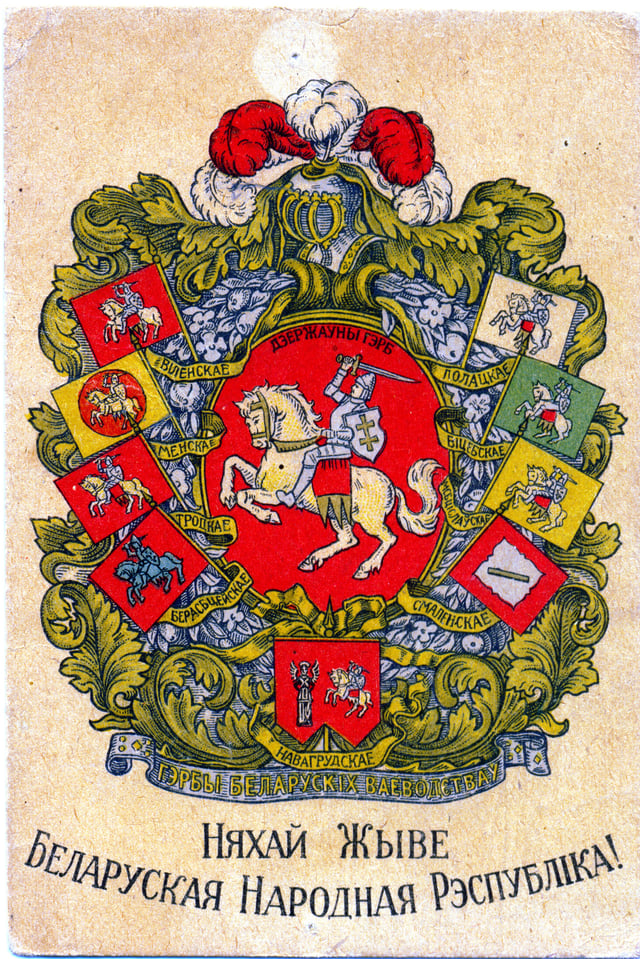
Belarusian People's Republic postcard with coats of arms of voivodeships
The Belarusian People's Republic was the first attempt to create an independent Belarusian state under name "Belarus".
Despite significant efforts the state ceased to exist, primarily because the territory was continually dominated by the German Imperial Army and the Imperial Russian Army in World War I, and then the Bolshevik Red Army. It existed only from 1918 to 1919 but created prerequisites for the formation of the state idea around the name "Belarus". The choice of the name was probably based the fact that the educated core of the newly formed government was educated in the tsardom universities, with a corresponding education around the ideology of West-Russianism.[68]
Republic of Central Lithuania
The Republic of Central Lithuania was a short-lived political entity, which was the last attempt to restore Lithuania in the historical confederacy state (it was also supposed to create Lithuania Upper and Lithuania Lower). The republic was created in 1920 following the staged rebellion of soldiers of the 1st Lithuanian–Belarusian Division of the Polish Army under Lucjan Żeligowski. Centered on the historical capital of the Grand Duchy of Lithuania, Vilna (Lithuanian: Vilnius, Polish: Wilno), for 18 months the entity served as a buffer state between Poland, upon which it depended, and Lithuania, which claimed the area.[69] After a variety of delays, a disputed election took place on 8 January 1922, and the territory was annexed to Poland. Żeligowski later in his memoir which was published in London in 1943 condemned the annexation of Republic by Poland, as well as the policy of closing Belarusian schools and general disregard of Marshal Józef Piłsudski's confederation plans by Polish ally.[70] Years earlier interrogation report of 19-year-old revolutionary Pilsudski of March 10, 1887 indicated that he called himself a "belarusian, nobleman".[71]
Byelorussian Soviet Socialist Republic

Location of Byelorussia (red) within the Soviet Union.
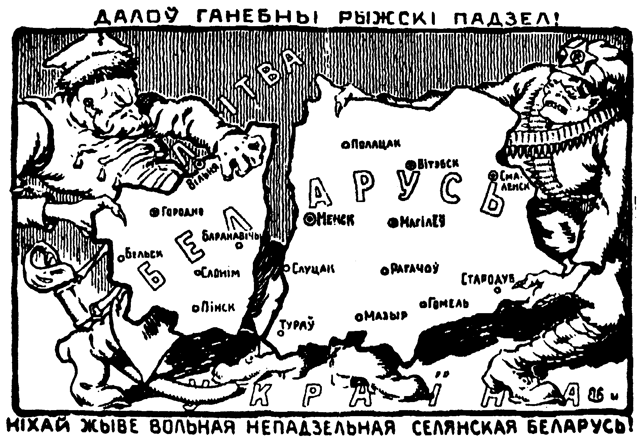
Caricature illustrating the partition of Belarus between Poland and the Bolsheviks after the Peace of Riga, 1921

Soviet partisan fighters behind German front lines in Belarus in 1943

Khatyn Memorial. The Nazis murdered civilians in 5,295 different localities in occupied Soviet Belarus.
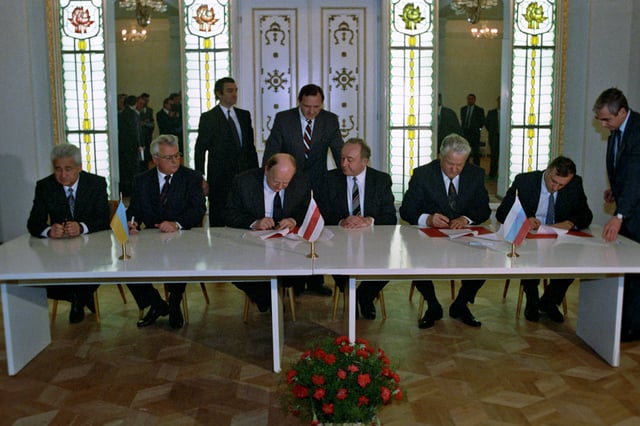
Leaders of Russia, Ukraine and Belarus signed the Belavezha Accords, dissolving the Soviet Union, 8 December 1991
A part of Belarus under Russian rule emerged as the Byelorussian Soviet Socialist Republic (Byelorussian SSR) in 1919. Soon thereafter it merged to form the Lithuanian-Byelorussian SSR. The contested lands were divided between Poland and the Soviet Union after the war ended in 1921, and the Byelorussian SSR became a founding member of the Union of Soviet Socialist Republics in 1922.[64][72] The western part of modern Belarus remained part of Poland.[73][74][75]
In the 1920s and 1930s, Soviet agricultural and economic policies, including collectivization and five-year plans for the national economy, led to famine and political repression.[76]
In 1939, Nazi Germany and the Soviet Union invaded and occupied Poland, marking the beginning of World War II. The Soviets invaded and annexed much of eastern Poland, which had been part of the country since the Peace of Riga two decades earlier. Much of the northern section of this area was added to the Byelorussian SSR, and now constitutes West Belarus.[9][10][11][77] The Soviet-controlled Byelorussian People's Council officially took control of the territories, whose populations consisted of a mixture of Poles, Ukrainians, Belarusians and Jews, on 28 October 1939 in Białystok. Nazi Germany invaded the Soviet Union in 1941. The Brest Fortress, which had been annexed in 1939, at this time was subjected to one of the most destructive onslaughts that happened during the war. Statistically, the Byelorussian SSR was the hardest-hit Soviet republic in World War II; it remained in Nazi hands until 1944. During that time, Germany destroyed 209 out of 290 cities in the republic, 85% of the republic's industry, and more than one million buildings.[12] The Nazi Generalplan Ost called for the extermination, expulsion or enslavement of most or all Belarusians for the purpose of providing more living space in the East for Germans.[78]
Deaths are estimated to be over 1 million, the Jewish population of Belarus was devastated during the Holocaust and never recovered.[12][79][80][81] The population of Belarus did not regain its pre-war level until 1971.[79] It was also after this conflict that the final borders of Belarus were set by Stalin when parts of Belarusian territory were given to the recently annexed Lithuania.[77]
After the war, Belarus was among the 51 founding countries of the United Nations Charter and as such it was allowed an additional vote at the UN, on top of the Soviet Union's vote. Vigorous postwar reconstruction promptly followed the end of the war and the Byelorussian SSR became a major center of manufacturing in the western USSR, creating jobs and attracting ethnic Russians.[82] The borders of the Byelorussian SSR and Poland were redrawn, in accord with the 1919-proposed Curzon Line.[59]
Joseph Stalin implemented a policy of Sovietization to isolate the Byelorussian SSR from Western influences.[79] This policy involved sending Russians from various parts of the Soviet Union and placing them in key positions in the Byelorussian SSR government. After Stalin's death in 1953, Nikita Khrushchev continued his predecessor's cultural hegemony program, stating, "The sooner we all start speaking Russian, the faster we shall build communism."[79]
In June 1988, the archaeologist and leader of the Christian Conservative Party of the BPF Zyanon Paznyak discovered mass graves of victims executed in 1937–41 at Kurapaty, near Minsk.[83] Some nationalists contend that this discovery is proof that the Soviet government was trying to erase the Belarusian people, causing Belarusian nationalists to seek independence.[84]
Independence
In March 1990, elections for seats in the Supreme Soviet of the Byelorussian SSR took place. Though the pro-independence Belarusian Popular Front took only 10% of the seats, the populace was content with the selection of the delegates.[85] Belarus declared itself sovereign on 27 July 1990 by issuing the Declaration of State Sovereignty of the Belarusian Soviet Socialist Republic.
With the support of the Communist Party, the country's name was changed to the Republic of Belarus on 25 August 1991.[85] Stanislav Shushkevich, the chairman of the Supreme Soviet of Belarus, met with Boris Yeltsin of Russia and Leonid Kravchuk of Ukraine on 8 December 1991 in Belavezhskaya Pushcha to formally declare the dissolution of the Soviet Union and the formation of the Commonwealth of Independent States.[85]
A national constitution was adopted in March 1994 in which the functions of prime minister were given to the President of Belarus.
Post-independence
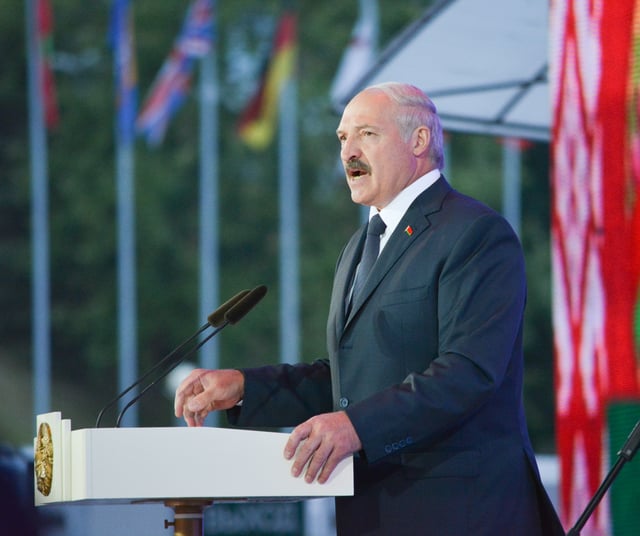
Alexander Lukashenko has ruled Belarus since 1994, and is Europe's longest currently ruling elected head of state.
Two-round elections for the presidency on (24 June 1994 and 10 July 1994)[86] catapulted the formerly unknown Alexander Lukashenko into national prominence. He garnered 45% of the vote in the first round and 80%[85] in the second, defeating Vyacheslav Kebich who received 14% of the vote. Lukashenko was re-elected in 2001, in 2006, in 2010 and again in 2015. Western governments,[87] Amnesty International,[19] and Human Rights Watch[18] have criticized Lukashenko's authoritarian style of government.
Since 2014, following years of embrace of Russian influence in the country, Lukashenko has pressed a revival of Belarusian identity, following the Russian annexation of Crimea and military intervention in Eastern Ukraine. For the first time, he delivered a speech in Belarusian (rather than Russian, which most people use), in which he said, "We are not Russian—we are Belarusians", and later encouraged the use of Belarusian. Trade disputes, a border dispute, and a much relaxed official attitude to dissident voices are all part of a weakening of the longtime warm relationship with Russia.[88]
In 2019, Lukashenko had bilateral talks in Sochi with Russian president Vladimir Putin and declared that their two countries "could unite tomorrow, no problem."[89] An idea backed by Putin for years, observers have labeled the potential plan a scheme by Putin to remain in power beyond 2024.[90] However, political scientist Mikhail Vinogradov explained that "Lukashenko will play tough to the public while trying to look weak in front of Putin," and the Carnegie Moscow Center's Artyom Shraibman suggested that "Moscow will most likely fail to find its base among Belarusians."[91]
Geography and climate
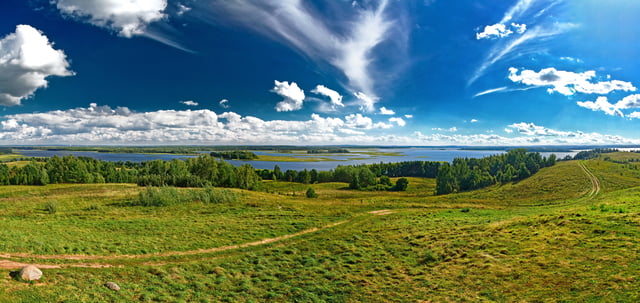
Strusta Lake in the Vitebsk Region
Belarus lies between latitudes 51° and 57° N, and longitudes 23° and 33° E. Its extension from north to south is 560 km (350 mi), from west to east is 650 km (400 mi).[92] It is landlocked, relatively flat, and contains large tracts of marshy land.[93] About 40% of Belarus is covered by forests.[94][95]
The highest point is Dzyarzhynskaya Hara (Dzyarzhynsk Hill) at 345 metres (1,132 ft), and the lowest point is on the Neman River at 90 m (295 ft).[93] The average elevation of Belarus is 160 m (525 ft) above sea level.[97] The climate features mild to cold winters, with average January minimum temperatures ranging from −4 °C (24.8 °F) in southwest (Brest) to −8 °C (17.6 °F) in northeast (Vitebsk), and cool and moist summers with an average temperature of 18 °C (64.4 °F).[98] Belarus has an average annual rainfall of 550 to 700 mm (21.7 to 27.6 in).[98] The country is in the transitional zone between continental climates and maritime climates.[93]
Natural resources include peat deposits, small quantities of oil and natural gas, granite, dolomite (limestone), marl, chalk, sand, gravel, and clay.[93] About 70% of the radiation from neighboring Ukraine's 1986 Chernobyl nuclear disaster entered Belarusian territory, and about a fifth of Belarusian land (principally farmland and forests in the southeastern regions) was affected by radiation fallout.[99] The United Nations and other agencies have aimed to reduce the level of radiation in affected areas, especially through the use of caesium binders and rapeseed cultivation, which are meant to decrease soil levels of caesium-137.[100][101]
Belarus borders five countries: Latvia to the north, Lithuania to the northwest, Poland to the west, Russia to the north and the east, and Ukraine to the south. Treaties in 1995 and 1996 demarcated Belarus's borders with Latvia and Lithuania, and Belarus ratified a 1997 treaty establishing the Belarus-Ukraine border in 2009.[102] Belarus and Lithuania ratified final border demarcation documents in February 2007.[102]
| Location | July (°C) | July (°F) | January (°C) | January (°F) |
|---|---|---|---|---|
| Minsk | 23/14 | 74/57 | −2/−6 | 28/20 |
| Gomel | 25/15 | 77/58 | −2/−7 | 28/19 |
| Mogilev | 23/12 | 74/55 | −1/−6 | 30/21 |
| Vitebsk | 23/13 | 74/56 | −3/−7 | 26/18 |
| Grodno | 24/12 | 75/55 | −1/−6 | 30/21 |
| Brest | 25/14 | 83/61 | 0/−5 | 31/23 |
Governance
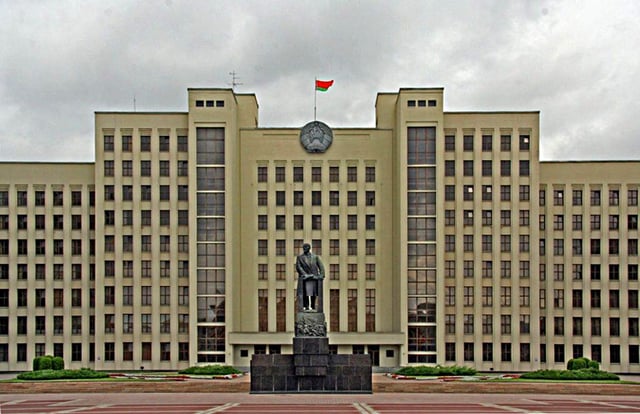
House of Representatives of Belarus
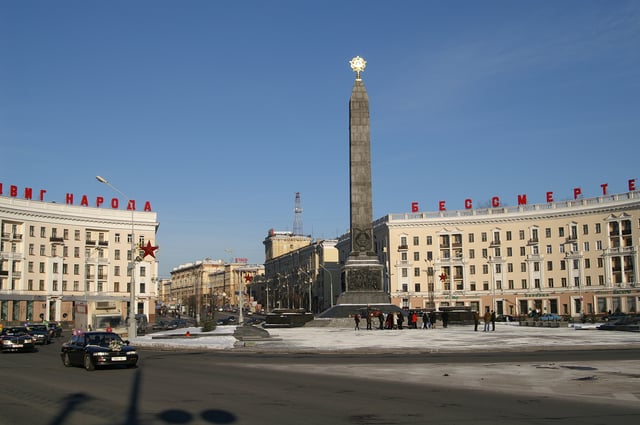
Victory Square in Minsk
Belarus is a presidential republic, governed by a president and the National Assembly. The term for each presidency is five years. Under the 1994 constitution, the president could serve for only two terms as president, but a change in the constitution in 2004 eliminated term limits.[105] Alexander Lukashenko has been the president of Belarus since 1994. In 1996, Lukashenko called for a controversial vote to extend the presidential term from five to seven years, and as a result the election that was supposed to occur in 1999 was pushed back to 2001. The referendum on the extension was denounced as a "fantastic" fake by the chief electoral officer, Viktar Hanchar, who was removed from the office for official matters only during the campaign.[106] The National Assembly is a bicameral parliament comprising the 110-member House of Representatives (the lower house) and the 64-member Council of the Republic (the upper house).[107]
The House of Representatives has the power to appoint the prime minister, make constitutional amendments, call for a vote of confidence on the prime minister, and make suggestions on foreign and domestic policy.[108] The Council of the Republic has the power to select various government officials, conduct an impeachment trial of the president, and accept or reject the bills passed by the House of Representatives. Each chamber has the ability to veto any law passed by local officials if it is contrary to the constitution.[109]
The government includes a Council of Ministers, headed by the prime minister and five deputy prime ministers.[110] The members of this council need not be members of the legislature and are appointed by the president.
The judiciary comprises the Supreme Court and specialized courts such as the Constitutional Court, which deals with specific issues related to constitutional and business law. The judges of national courts are appointed by the president and confirmed by the Council of the Republic. For criminal cases, the highest court of appeal is the Supreme Court. The Belarusian Constitution forbids the use of special extrajudicial courts.[109]
In the 2012 parliamentary election, 105 of the 110 members elected to the House of Representatives were not affiliated with any political party. The Communist Party of Belarus won 3 seats, and the Agrarian Party and Republican Party of Labour and Justice, one each.[111] Most non-partisans represent a wide scope of social organizations such as workers' collectives, public associations, and civil society organizations, similar to the composition of the Soviet legislature.[112]
Election controversies
Neither the pro-Lukashenko parties, such as the Belarusian Socialist Sporting Party and the Republican Party of Labour and Justice, nor the People's Coalition 5 Plus opposition parties, such as the Belarusian People's Front and the United Civil Party of Belarus, won any seats in the 2004 elections. Groups such as the Organization for Security and Co-operation in Europe (OSCE) declared the election "un-free" because of the opposition parties' poor results and media bias in favor of the government.[113]
In the 2006 presidential election, Lukashenko was opposed by Alaksandar Milinkievič, who represented a coalition of opposition parties, and by Alaksandar Kazulin of the Social Democrats. Kazulin was detained and beaten by police during protests surrounding the All Belarusian People's Assembly. Lukashenko won the election with 80% of the vote; the Russian Federation and the CIS deemed the vote open and fair[114] while the OSCE and other organizations called the election unfair.[115]
After the December completion of the 2010 presidential election, Lukashenko was elected to a fourth straight term with nearly 80% of the vote in elections. The runner-up opposition leader Andrei Sannikov received less than 3% of the vote; independent observers criticized the election as fraudulent. When opposition protesters took to the streets in Minsk, many people, including most rival presidential candidates, were beaten and arrested by the state militia.[116] Many of the candidates, including Sannikov, were sentenced to prison or house arrest for terms which are mainly and typically over four years.[117][118] Six months later amid an unprecedented economic crisis, activists utilized social networking to initiate a fresh round of protests characterized by wordless hand-clapping.[119]
Corruption
The judicial system in Belarus lacks independence and is subject to political interference.[120] Corrupt practices such as bribery often took place during tender processes, and whistleblower protection and national ombudsman are lacking in Belarus's anti-corruption system.[121] However, there is a political will to fight against corruption in the government, and the government has made some progress in combating corruption, such as minimizing tax regulations in order to improve transparency in the tax office.[122]
Human rights

Flag which served as the national flag in 1918 and from 1991 to 1995.
Lukashenko has described himself as having an "authoritarian ruling style".[105] Western countries have described Belarus under Lukashenko as a dictatorship; the government has accused the same Western powers of trying to oust Lukashenko.[123] The Council of Europe has barred Belarus from membership since 1997 for undemocratic voting and election irregularities in the November 1996 constitutional referendum and parliament by-elections.[124]
The Belarusian government is also criticized for human rights violations and its persecution of non-governmental organisations, independent journalists, national minorities, and opposition politicians.[19][18] In a testimony to the United States Senate Committee on Foreign Relations, former United States Secretary of State Condoleezza Rice labeled Belarus as one of the world's six "outposts of tyranny".[125] In response, the Belarusian government called the assessment "quite far from reality".[126] The Viasna Human Rights Centre lists 11 political prisoners[127] currently detained in Belarus. Among them is the human rights activist Ales Bialiatski, Vice President of International Federation for Human Rights and head of Viasna.[128]
Lukashenko announced a new law in 2014 that will prohibit kolkhoz workers (around 9% of total work force) from leaving their jobs at will—a change of job and living location will require permission from governors. The law was compared with serfdom by Lukashenko himself.[129][130] Similar regulations were introduced for the forestry industry in 2012.[131]
Foreign relations
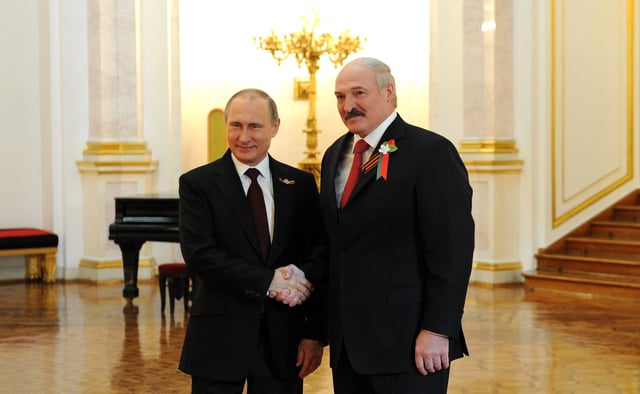
President Alexander Lukashenko, shaking hands with Russian President Vladimir Putin, 2015
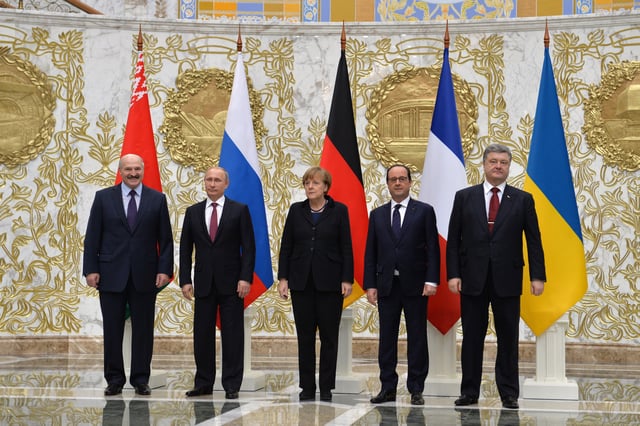
Leaders of Belarus, Russia, Germany, France, and Ukraine at the summit in Minsk, 11–12 February 2015
The Byelorussian SSR was one of the two Soviet republics that joined the United Nations along with the Ukrainian SSR as one of the original 51 members in 1945. After the dissolution of the Soviet Union, under international law, Belarus became the internationally recognized successor state to the Byelorussian SSR, retaining its UN membership.
Belarus and Russia have been close trading partners and diplomatic allies since the breakup of the Soviet Union.
Belarus is dependent on Russia for imports of raw materials and for its export market.[132]
The union of Russia and Belarus, a supranational confederation, was established in a 1996–99 series of treaties that called for monetary union, equal rights, single citizenship, and a common foreign and defense policy.[132] However, the future of the union has been placed in doubt because of Belarus's repeated delays of monetary union, the lack of a referendum date for the draft constitution, and a dispute over the petroleum trade.[132]
On 11 December 2007, reports emerged that a framework for the new state was discussed between both countries.[133] On 27 May 2008, Belarusian President Lukashenko said that he had named Russian Prime Minister Vladimir Putin the "prime minister" of the Russia-Belarus alliance. The significance of this act was not immediately clear; some incorrectly speculated that Putin would become president of a unified state of Russia and Belarus after stepping down as Russian president in May 2008.[134]
Belarus was a founding member of the Commonwealth of Independent States (CIS).[135] Belarus has trade agreements with several European Union member states (despite other member states' travel ban on Lukashenko and top officials),[136] including neighboring Latvia, Lithuania, and Poland.[137] Travel bans imposed by the European Union have been lifted in the past in order to allow Lukashenko to attend diplomatic meetings and also to engage his government and opposition groups in dialogue.[138]
Bilateral relations with the United States are strained because the U.S. Department of State supports various anti-Lukashenko non-governmental organizations (NGOs), and also because the Belarusian government has made it increasingly difficult for United States-based organizations to operate within the country.[139] Diplomatic relations remained tense, and in 2004, the United States passed the Belarus Democracy Act, which authorized funding for anti-government Belarusian NGOs, and prohibited loans to the Belarusian government, except for humanitarian purposes.[140] Despite this political friction, the two countries do cooperate on intellectual property protection, prevention of human trafficking, technology crime, and disaster relief.[141]
Sino-Belarusian relations have improved,[142] strengthened by the visit of President Lukashenko to China in October 2005.[143] Belarus also has strong ties with Syria,[144] considered a key partner in the Middle East.[145] In addition to the CIS, Belarus is a member of the Eurasian Economic Community, the Collective Security Treaty Organisation,[137] the international Non-Aligned Movement since 1998,[146] and the Organization on Security and Cooperation in Europe (OSCE). As an OSCE member state, Belarus's international commitments are subject to monitoring under the mandate of the U.S. Helsinki Commission.[147]
Belarus is included in the European Union's European Neighbourhood Policy (ENP) which aims at bringing the EU and its neighbours closer.
On 15 February 2016 the European Union announced the easing of sanctions against Belarus during a meeting by 28 EU foreign ministers at a regular session of the Council of the European Union.[148]
Military
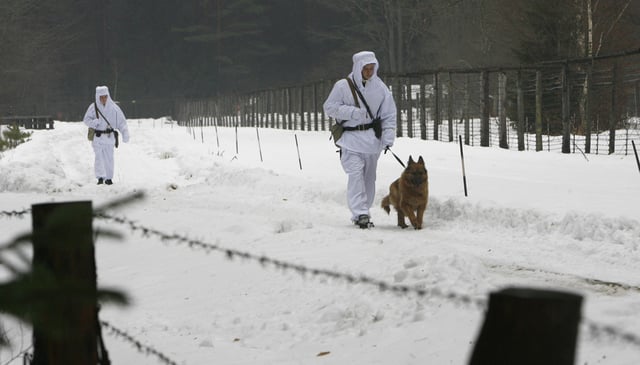
Soldiers patrol in the Białowieża Forest on the Belarusian border with Poland.
Major General Andrei Ravkov heads the Ministry of Defence,[149] and Alexander Lukashenko (as president) serves as Commander-in-Chief.[109] The armed forces were formed in 1992 using parts of the former Soviet Armed Forces on the new republic's territory. The transformation of the ex-Soviet forces into the Armed Forces of Belarus, which was completed in 1997, reduced the number of its soldiers by 30,000 and restructured its leadership and military formations.[150]
Most of Belarus's service members are conscripts, who serve for 12 months if they have higher education or 18 months if they do not.[151] Demographic decreases in the Belarusians of conscription age have increased the importance of contract soldiers, who numbered 12,000 in 2001.[152] In 2005, about 1.4% of Belarus's gross domestic product was devoted to military expenditure.[153]
Belarus has not expressed a desire to join NATO but has participated in the Individual Partnership Program since 1997,[154] and Belarus provides refueling and airspace support for the ISAF mission in Afghanistan.[155] Belarus first began to cooperate with NATO upon signing documents to participate in their Partnership for Peace Program in 1995.[156] However, Belarus cannot join NATO because it is a member of the Collective Security Treaty Organisation. Tensions between NATO and Belarus peaked after the March 2006 presidential election in Belarus.[157]
Administrative divisions
Belarus is divided into six regions (Belarusian: вобласць, Russian: о́бласть), which are named after the cities that serve as their administrative centers.[158]
Each region has a provincial legislative authority, called a region council (Belarusian: абласны Савет Дэпутатаў, Russian: областно́й Сове́т Депутатов), which is elected by its residents, and a provincial executive authority called a region administration (Belarusian: абласны выканаўчы камітэт, Russian: областно́й исполнительный комите́т), whose chairman is appointed by the president.[159] Regions are further subdivided into raions, commonly translated as districts (Belarusian: раён, Russian: район).[158]
Each raion has its own legislative authority, or raion council, (Belarusian: раённы Савет Дэпутатаў, Russian: районный Сове́т Депутатов) elected by its residents, and an executive authority or raion administration appointed by higher executive powers. The six regions are divided into 118 raions.[94]
Regions (with administrative centers):
Brest Region (Brest)
Gomel Region (Gomel)
Grodno Region (Grodno)
Mogilev Region (Mogilev)
Minsk Region (Minsk)
Vitebsk Region (Vitebsk)
Special administrative district:
Capital punishment
Belarus is the only European country still using capital punishment. The U.S. and Belarus were the only two of the 56 member states of the Organization for Security and Cooperation in Europe to have carried out executions during 2011.[162]
Economy
Industry
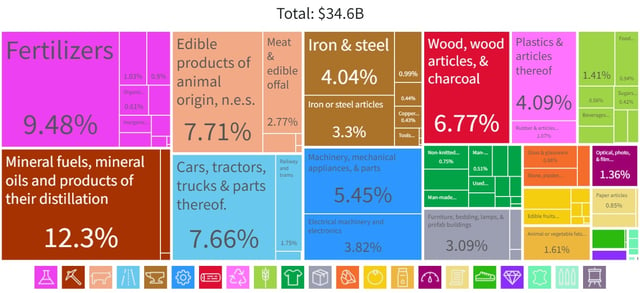
A graphical depiction of Belarus's product exports in 28 colour-coded categories
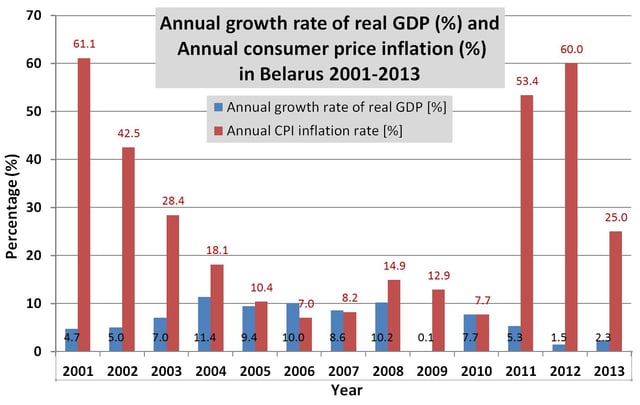
Belarusian annual GDP and CPI rates 2001–2013
In 2014 the share of manufacturing in GDP was 37%, more than two thirds of this amount falls on manufacturing industries.
The number of people employed in industry is 32.7% of the working population.
The growth rate is much lower than for the economy as a whole – about 1.9% in 2014.
At the time of the dissolution of the Soviet Union in 1991, Belarus was one of the world's most industrially developed states by percentage of GDP as well as the richest CIS member-state.[163]
In 2015, 39.3% of Belarusians were employed by state-controlled companies, 57.2% were employed by private companies (in which the government has a 21.1% stake) and 3.5% were employed by foreign companies.[164] The country relies on Russia for various imports, including petroleum.[165][166] Important agricultural products include potatoes and cattle byproducts, including meat.[153] In 1994, Belarus's main exports included heavy machinery (especially tractors), agricultural products, and energy products.[168] Economically, Belarus involved itself in the CIS, Eurasian Economic Community, and Union with Russia.
In the 1990s, however, industrial production plunged due to decreases in imports, investment, and demand for Belarusian products from its trading partners.[169] GDP only began to rise in 1996;[170] the country was the fastest-recovering former Soviet republic in the terms of its economy.[171] In 2006, GDP amounted to US$83.1 billion in purchasing power parity (PPP) dollars (estimate), or about $8,100 per capita.[153] In 2005, GDP increased by 9.9%; the inflation rate averaged 9.5%.[153]
Since the disintegration of the Soviet Union, under Lukashenko's leadership, Belarus has maintained government control over key industries and eschewed the large-scale privatizations seen in other former Soviet republics.
In 2006, Belarus's largest trading partner was Russia, accounting for nearly half of total trade, with the European Union the next largest trading partner, with nearly a third of foreign trade.[172][173] As of 2015, 38% of Belarusian exported goods go to Russia and 56% of imported goods come from Russia.[164]
Due to its failure to protect labor rights, including passing laws forbidding unemployment or working outside of state-controlled sectors,[174] Belarus lost its EU Generalized System of Preferences status on 21 June 2007, which raised tariff rates to their prior most favored nation levels.[173] Belarus applied to become a member of the World Trade Organization in 1993.[175]
The labor force consists of more than four million people, among whom women hold slightly more jobs than men.[164] In 2005, nearly a quarter of the population was employed by industrial factories.
Employment is also high in agriculture, manufacturing sales, trading goods, and education.
The unemployment rate, according to government statistics, was 1.5% in 2005.
There were 679,000 unemployed Belarusians, two-thirds of whom were women.
The unemployment rate has been in decline since 2003, and the overall rate of employment is the highest since statistics were first compiled in 1995.[164]
Until 1 July 2016, the currency of Belarus was the Belarusian ruble (BYR). The currency was introduced in May 1992, replacing the Soviet ruble. The first coins of the Republic of Belarus were issued on 27 December 1996.[176] The ruble was reintroduced with new values in 2000 and has been in use ever since.[176] As part of the Union of Russia and Belarus, both states have discussed using a single currency along the same lines as the Euro. This led to a proposal that the Belarusian ruble be discontinued in favor of the Russian ruble (RUB), starting as early as 1 January 2008. The National Bank of Belarus abandoned pegging the Belarusian ruble to the Russian ruble in August 2007.[178]
A new currency, the new Belarusian ruble (ISO 4217 code: BYN)[179] was introduced in July 2016, replacing the Belarusian ruble in a rate of 1:10,000 (10,000 old rubles = 1 new ruble). From 1 July until 31 December 2016, the old and new currencies will be in parallel circulation and series 2000 notes and coins can be exchanged for series 2009 from 1 January 2017 to 31 December 2021.[179] This redenomination can be considered an effort to fight the high inflation rate.[180][181][182]
The banking system of Belarus consists of two levels: Central Bank (National Bank of the Republic of Belarus) and 25 commercial banks.[183] On 23 May 2011, the Belarusian ruble depreciated 56% against the United States dollar.
The depreciation was even steeper on the black market and financial collapse seemed imminent as citizens rushed to exchange their rubles for dollars, euros, durable goods, and canned goods.[184] On 1 June 2011, Belarus requested an economic rescue package from the International Monetary Fund.[185][186]
Demographics
According to the National Statistical Committee, as of January 2016, the population is 9.49 million.[1] Ethnic Belarusians constitute 83.7% of Belarus's total population.[1] The next largest ethnic groups are: Russians (8.3%), Poles (3.1%), and Ukrainians (1.7%).[1] Belarus has a population density of about 50 people per square kilometer (127 per sq mi); 70% of its total population is concentrated in urban areas.[187] Minsk, the nation's capital and largest city, was home to 1,937,900 residents in 2015.[188] Gomel, with a population of 481,000, is the second-largest city and serves as the capital of the Homiel Voblast. Other large cities are Mogilev (365,100), Vitebsk (342,400), Hrodna (314,800) and Brest (298,300).[189]
Like many other eastern European countries, Belarus has a negative population growth rate and a negative natural growth rate.
In 2007, Belarus's population declined by 0.41% and its fertility rate was 1.22,[93] well below the replacement rate. Its net migration rate is +0.38 per 1,000, indicating that Belarus experiences slightly more immigration than emigration. As of 2015, 69.9% of Belarus's population is aged 14 to 64; 15.5% is under 14, and 14.6% is 65 or older. Its population is also aging; the median age of 30–34 is estimated to rise to between 60 and 64 in 2050.[191] There are about 0.87 males per female in Belarus.[93] The average life expectancy is 72.15 (66.53 years for men and 78.1 years for women).[93] Over 99% of Belarusians aged 15 and older are literate.[93]
Languages
Belarus's two official languages are Russian and Belarusian;[192] Russian is the most common language used at home, used by 70% of the population, while Belarusian, the official first language, is spoken at home by 23%.[193] Minorities also speak Polish, Ukrainian and Eastern Yiddish.[194] Belarusian, although not as widely used as Russian, is the mother tongue of 53.2% of the population, whereas Russian is the mother tongue of only 41.5%.[193]
Religion
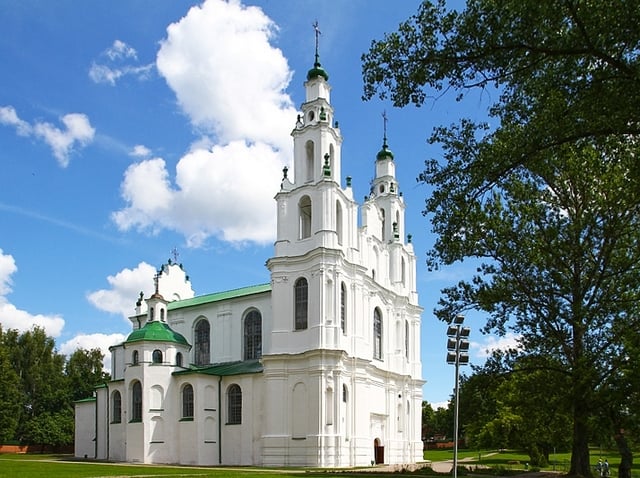
Saint Sophia Cathedral in Polotsk is one of the oldest churches in Belarus. Its current style is an ideal example of baroque architecture in the former Polish–Lithuanian Commonwealth
According to the census of as of November 2011, 58.9% of all Belarusians adhere to some kind of religion; out of those, Eastern Orthodoxy (Belarusian Exarchate of the Russian Orthodox Church) makes up about 82%.[195] Roman Catholicism is practiced mostly in the western regions, and there are also different denominations of Protestantism.[196][197] Minorities also practice Greek Catholicism, Judaism, Islam and Neopaganism. Overall, 48.3% of the population is Orthodox Christian, 41.1% is not religious, 7.1% is Catholic and 3.3% follows other religions.[195]
Belarus's Catholic minority is concentrated in the western part of the country, especially around Hrodna, is made up of a mixture of Belarusians and the country's Polish and Lithuanian minorities.[198] In a statement to the media regarding Belarusian-Vatican ties, President Lukashenko stated that Orthodox and Catholic believers are the "two main confessions in our country".[199]
Belarus was once a major center of European Jews, with 10% of the population being Jewish. But since the mid-20th century, the number of Jews has been reduced by the Holocaust, deportation, and emigration, so that today it is a very small minority of less than one percent.[200] The Lipka Tatars, numbering over 15,000, are predominantly Muslims. According to Article 16 of the Constitution, Belarus has no official religion. While the freedom of worship is granted in the same article, religious organizations deemed harmful to the government or social order can be prohibited.[158]
Culture
Arts and literature
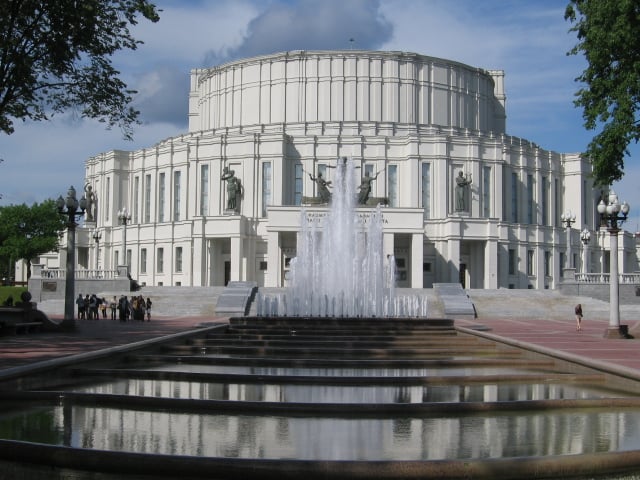
The Opera and Ballet Theater in Minsk

Poet and librettist Vintsent Dunin-Martsinkyevich
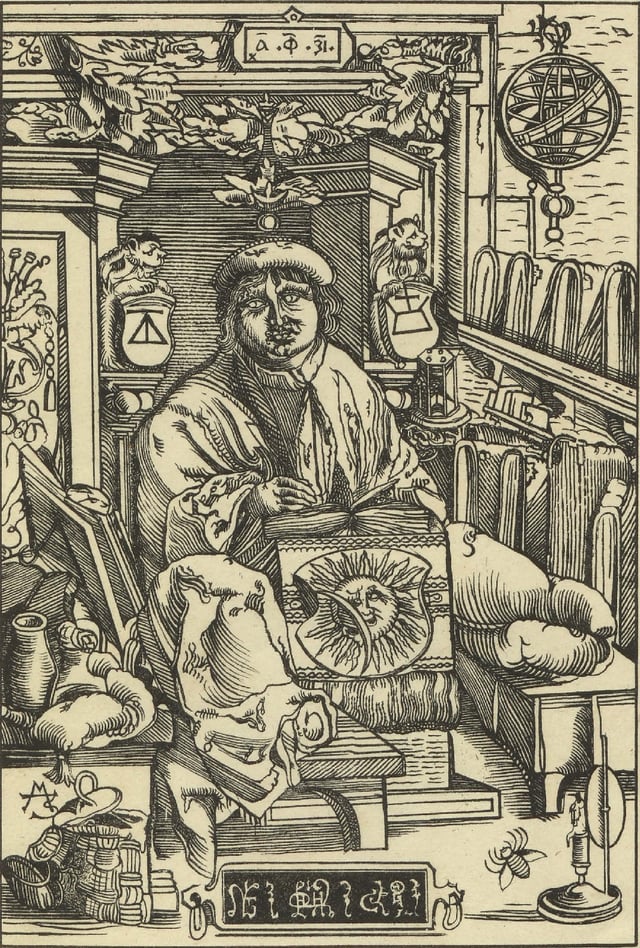
Francysk Skaryna, developer of the Belarusian language, and one of the first people to print in the Cyrillic alphabet
The Belarusian government sponsors annual cultural festivals such as the Slavianski Bazaar in Vitebsk,[201] which showcases Belarusian performers, artists, writers, musicians, and actors. Several state holidays, such as Independence Day and Victory Day, draw big crowds and often include displays such as fireworks and military parades, especially in Vitebsk and Minsk.[202] The government's Ministry of Culture finances events promoting Belarusian arts and culture both inside and outside the country.
By the 16th century, Polotsk resident Francysk Skaryna translated the Bible into Belarusian. It was published in Prague and Vilnius sometime between 1517 and 1525, making it the first book printed in Belarus or anywhere in Eastern Europe.[205] The modern era of Belarusian literature began in the late 19th century; one prominent writer was Yanka Kupala. Many Belarusian writers of the time, such as Uładzimir Žyłka, Kazimir Svayak, Yakub Kolas, Źmitrok Biadula, and Maksim Haretski, wrote for Nasha Niva, a Belarusian-language paper published that was previously published in Vilnius but now is published in Minsk.[206]
After Belarus was incorporated into the Soviet Union, the Soviet government took control of the Republic's cultural affairs.
At first, a policy of "Belarusianization" was followed in the newly formed Byelorussian SSR.
This policy was reversed in the 1930s, and the majority of prominent Belarusian intellectuals and nationalist advocates were either exiled or killed in Stalinist purges.[207] The free development of literature occurred only in Polish-held territory until Soviet occupation in 1939.
Several poets and authors went into exile after the Nazi occupation of Belarus and would not return until the 1960s.[205]
The last major revival of Belarusian literature occurred in the 1960s with novels published by Vasil Bykaŭ and Uladzimir Karatkievich. An influential author who devoted his work to awakening the awareness of the catastrophes the country has suffered, was Ales Adamovich. He was named by Svetlana Alexievich, the Belarusian winner of the Nobel Prize in Literature 2015, as "her main teacher, who helped her to find a path of her own".[208]
Music in Belarus largely comprises a rich tradition of folk and religious music. The country's folk music traditions can be traced back to the times of the Grand Duchy of Lithuania. In the 19th century, Polish composer Stanisław Moniuszko composed operas and chamber music pieces while living in Minsk. During his stay, he worked with Belarusian poet Vintsent Dunin-Martsinkyevich and created the opera Sialanka (Peasant Woman). At the end of the 19th century, major Belarusian cities formed their own opera and ballet companies. The ballet Nightingale by M. Kroshner was composed during the Soviet era and became the first Belarusian ballet showcased at the National Academic Vialiki Ballet Theatre in Minsk.[209]
After the Second World War, music focused on the hardships of the Belarusian people or on those who took up arms in defense of the homeland. During this period, Anatoly Bogatyrev, creator of the opera In Polesye Virgin Forest, served as the "tutor" of Belarusian composers.[210] The National Academic Theatre of Ballet in Minsk was awarded the Benois de la Dance Prize in 1996 as the top ballet company in the world.[210] Rock music has become increasingly popular in recent years, though the Belarusian government has attempted to limit the amount of foreign music aired on the radio in favor of traditional Belarusian music. Since 2004, Belarus has been sending artists to the Eurovision Song Contest.[211][212]
Marc Chagall was born in Liozna (near Vitebsk) in 1887. He spent the World War I years in Soviet Belarus, becoming one of the country's most distinguished artists and a member of the modernist avant-garde and was a founder of the Vitebsk Arts College.[213][214]
Dress
The traditional Belarusian dress originates from the Kievan Rus' period. Due to the cool climate, clothes were designed to preserve body heat and were usually made from flax or wool. They were decorated with ornate patterns influenced by the neighboring cultures: Poles, Lithuanians, Latvians, Russians, and other European nations. Each region of Belarus has developed specific design patterns.[215] One ornamental pattern common in early dresses currently decorates the hoist of the Belarusian national flag, adopted in a disputed referendum in 1995.[216]
Cuisine

Draniki, the national dish
Belarusian cuisine consists mainly of vegetables, meat (particularly pork), and bread. Foods are usually either slowly cooked or stewed. Typically, Belarusians eat a light breakfast and two hearty meals later in the day. Wheat and rye breads are consumed in Belarus, but rye is more plentiful because conditions are too harsh for growing wheat. To show hospitality, a host traditionally presents an offering of bread and salt when greeting a guest or visitor.[217]
Sport

Victoria Azarenka, professional tennis player and a former world No. 1 in singles
Belarus has competed in the Olympic Games since the 1994 Winter Olympics. Its National Olympic Committee has been headed by President Lukashenko since 1997.[218]
Receiving heavy sponsorship from the government, ice hockey is the nation's second most popular sport after football. The national football team has never qualified for a major tournament; however, BATE Borisov has played in the Champions League. The national hockey team finished fourth at the 2002 Salt Lake City Olympics following a memorable upset win over Sweden in the quarterfinals, and regularly competes in the World Championships, often making the quarterfinals. Numerous Belarusian players are present in the Kontinental Hockey League in Eurasia, particularly for Belarusian club HC Dinamo Minsk, and several have also played in the National Hockey League in North America. Darya Domracheva is a leading biathlete whose honours include three gold medals at the 2014 Winter Olympics.[219]
Tennis player Victoria Azarenka became the first Belarusian to win a Grand Slam singles title at the Australian Open in 2012.[220] She also won the gold medal in mixed doubles at the 2012 Summer Olympics with Max Mirnyi, who holds ten Grand Slam titles in doubles.
Other notable Belarusian sportspeople include cyclist Vasil Kiryienka, who won the 2015 Road World Time Trial Championship, and middle distance runner Maryna Arzamasava, who won the gold medal in the 800m at the 2015 World Championships in Athletics.
Belarus is also known for its strong rhythmic gymnasts.
Noticeable gymnasts include Inna Zhukova, who earned silver at the 2008 Beijing Olympics, Liubov Charkashyna, who earned bronze at the 2012 London Olympics and Melitina Staniouta, Bronze All-Around Medalist of the 2015 World Championships. The Belorussian senior group earned bronze at the 2012 London Olympics.
Andrei Arlovski, who was born in Babruysk, Byelorussian SSR, is a current UFC fighter and the former UFC heavyweight champion of the world.
Telecommunications
Country code: .by
The state telecom monopoly, Beltelecom, holds the exclusive interconnection with Internet providers outside of Belarus.
Beltelecom owns all the backbone channels that linked to the Lattelecom, TEO LT, Tata Communications (former Teleglobe), Synterra, Rostelecom, Transtelekom and MTS ISP's. Beltelecom is the only operator licensed to provide commercial VoIP services in Belarus.[221]
World Heritage Sites
Belarus has four UNESCO-designated World Heritage Sites: the Mir Castle Complex, the Nesvizh Castle, the Belovezhskaya Pushcha (shared with Poland), and the Struve Geodetic Arc (shared with nine other countries).[222]
See also
List of Belarus-related topics
Outline of Belarus